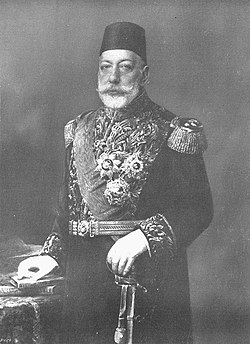
Back Mehmet V Afrikaans محمد الخامس العثماني Arabic محمد الخامس ARZ V Mehmed Azerbaijani بئشینجی محمد AZB Мехмед V Byelorussian Мэхмэд V BE-X-OLD Мехмед V Bulgarian পঞ্চম মুহাম্মদ Bengali/Bangla Mehmet V Breton
This article needs additional citations for verification. (April 2018) |
| Mehmed V | |||||
|---|---|---|---|---|---|
| Custodian of the Two Holy Mosques | |||||
 Photograph by Carl Pietzner, June 1915 | |||||
| Sultan of the Ottoman Empire (Padishah) | |||||
| Reign | 27 April 1909 – 3 July 1918 | ||||
| Predecessor | Abdul Hamid II | ||||
| Successor | Mehmed VI | ||||
| Grand Viziers | |||||
| Ottoman caliph (Amir al-Mu'minin) | |||||
| Predecessor | Abdul Hamid II | ||||
| Successor | Mehmed VI | ||||
| Born | 2 November 1844 Old Çırağan Palace, Constantinople, Ottoman Empire (present-day Istanbul, Turkey) | ||||
| Died | 3 July 1918 (aged 73) Yıldız Palace, Istanbul, Ottoman Empire | ||||
| Burial | Tomb of Sultan Mehmed V Reşad, Eyüp, Istanbul | ||||
| Consorts | |||||
| Issue | |||||
| |||||
| Dynasty | Ottoman | ||||
| Father | Abdulmejid I | ||||
| Mother | Gülcemal Kadın (biological mother) Servetseza Kadın (adoptive mother) | ||||
| Religion | Sunni Islam | ||||
| Tughra |  | ||||
Mehmed V Reşâd (Ottoman Turkish: محمد خامس, romanized: Meḥmed-i ḫâmis; Turkish: V. Mehmed or Mehmed Reşad; 2 November 1844 – 3 July 1918) was the penultimate sultan of the Ottoman Empire from 1909 to 1918. Mehmed V reigned as a constitutional monarch. He had little influence over government affairs and the Ottoman constitution was held with little regard by his ministries. The first half of his reign was marked by increasingly polarizing politics, and the second half by war and domination of the Committee of Union and Progress and the Three Pashas.
Reşad was the son of Sultan Abdulmejid I.[2] He succeeded his half-brother Abdul Hamid II after the 31 March Incident. Coming to power in the aftermath of the failed coup attempt, his nine-year reign featured three coups d'etat, four wars, eleven governments, and numerous uprisings. The Italo-Turkish War saw the cession of the Empire's North African territories and the Dodecanese Islands, including Rhodes, during which the CUP was forced out of power by the military. This was followed up by the traumatic loss of almost all of the Empire's European territories west of Constantinople (now Istanbul) in the First Balkan War, and the return of a now radicalized CUP rule in another coup. Eastern Thrace was retaken in the Second Balkan War.
The Ottomans entered World War I in November 1914, upon which Mehmed declared a jihad against the Allies. In 1915, Ottoman forces successfully fended off an Allied invasion at Gallipoli and captured a large British garrison at Kut. During that year, the CUP initiated the Armenian genocide against the Sultan's wishes, though his private disapproval over his governments' actions was inconsequential. By Mehmed V's death on 3 July 1918, defeat loomed on the Palestinian and Macedonian fronts. With military collapse in the field and the Arab Revolt spelling impending disaster, the Ottomans signed the Armistice of Mudros, though by then he was dead, and succeeded by Mehmed VI.[3]
- ^ "Asian, Ceramics & Works of Art: Antiquities, Islamic & Pre-Columbian Art". C.G. Sloan & Company. 2001.
- ^ Abdulmecid, Coskun Cakir, Encyclopedia of the Ottoman Empire, ed. Gábor Ágoston, Bruce Alan Masters, (Infobase Publishing, 2009), 9.
- ^ "Rusya Fransa ve İngiltere devletleriyle hal-i harb ilanı hakkında irade-i seniyye [Imperial Decree Concerning the Declaration of a State of War with the States of Russia, France, and the United Kingdom], Nov. 11, 1914 (29 Teşrin-i Evvel 1330), Takvim-i Vekayi, Nov. 12, 1914 (30 Teşrin-i Evvel 1330)" (PDF). Library of Congress.
© MMXXIII Rich X Search. We shall prevail. All rights reserved. Rich X Search